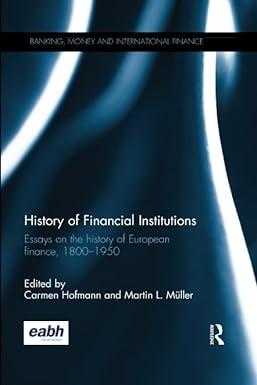Question
MULTIPLE-CHOICE QUESTIONS Each of the following sub-questions contains one statement but with multiple possible answers. Only one of the answers is correct. Read each statement
MULTIPLE-CHOICE QUESTIONS
Each of the following sub-questions contains one statement but with multiple possible
answers. Only one of the answers is correct. Read each statement very carefully and then
decide which one of the options is the correct one. In your examination script (answer book),
write down only the number of the sub-question and next to it the letter that represents the
answer you have selected.
Example: If you believe that for sub-question 1.11 option C is correct, then write down: 1.11.
C.
1.1. Why are finance costs excluded when preparing a cash budget using the operating
cash flow?
A. Finance cost is an external forecast item and, therefore, not used.
B. Finance cost is not a cash-flow item.
C. The objective of a cash budget is to measure the firms operations and not how
they are financed.
1.2. Who are the beneficiaries of a firms available free cash flow (FCF) after the firm has
met all its operating needs?
A. The directors
B. The investors
C. The employees
1.3. At what cost are the different sources of capital always valued when calculating the
weighted average cost of capital (WACC)?
A. The market value cost
B. The book value cost
C. The target value cost
1.4. What do firms wish to determine when using break-even analysis?
A. The extent of leverage in their capital structures
B. Their level of operations necessary to cover all cost
C. Their profitability
1.5. The most common statistical indicator of an assets risk is known as the _____
A. probability distribution.
B. expected value of the return.
C. standard deviation.
1.6. Which attitude towards risk best explains a risk-averse investor?
A. An increase in risk will be compensated for by an expected increase in return.
B. A higher return will not justify the increase in risk.
C. No change in return would be required for an increase in risk.
1.7. What expense does a company incur as a consequence of its financing activities?
A. Depreciation expense
B. Interest expense
C. Income tax expen
1.8. Which financial performance indicator is widely valued by using the constant growth
valuation method?
A. Free cash flow
B. Dividend
C. Earnings before interest and tax (EBIT)
1.9. What rate is used in the free cash flow valuation model to discount the cash flows?
A. The expected dividend growth rate
B. The internal rate of return (IRR)
C. The weighted average cost of capital (WACC)
1.10. A project can be accepted when _____
A. NPV > 0.
B. NPV < 0.
C. NPV = 0.
Step by Step Solution
There are 3 Steps involved in it
Step: 1

Get Instant Access to Expert-Tailored Solutions
See step-by-step solutions with expert insights and AI powered tools for academic success
Step: 2

Step: 3

Ace Your Homework with AI
Get the answers you need in no time with our AI-driven, step-by-step assistance
Get Started


